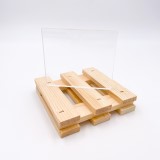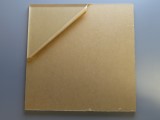Plastic sheeting with unique UV characteristics is often used where UV rays are an issue, whether it is UV filtering or transmitting. Applications that commonly see problems with traditional acrylic sheeting include display cases, museum lighting, animal habitats, tanning beds, and more. UV filtering acrylic sheet is used when UV light is not desired, and UV transmitting acrylic is used when UV light is required.
UV Filtering Acrylic
UV filtering acrylic is one of the most popular specialized acrylic sheeting solutions on the market today. Although UV filtering plexiglass can not completely prevent colors from fading or darkening, it does filter out up to 98% of harmful UV light. This makes it the ideal plastic sheet material for protecting artwork, paper, or other keepsakes, that can turn yellow, fade, and become brittle. It’s important to know that not all UV filtering plexiglass sheets are created equally, as some block more UV rays than others, and some even filter out harmful visible light rays. The UV protection of this acrylic sheeting only blocks UV wavelengths shorter than 400 nanometers. Visible light can also be harmful, especially in the lower violet range from 400-500 nanometers, and is blocked by certain kinds of UV filtering sheeting such as UF3 acrylic and museum grade acrylic.
Applications of UV Filtering Acrylic
Although the most common application of UV filtering acrylic plastic is for framing, this plexiglass is warranted for a variety of projects including:
- Museum Lighting
- Museum Glazing
- Mercury Vapor Lenses
- Window Glazing
- Skylights
- Fine Art Framing
- Exhibit Showcases
UV Transmitting Acrylic
Although UV filtering acrylic is more popular than UV transmitting and has more applications, UV transmitting acrylic is important in places where the UV rays are required. With impeccable clarity, excellent weatherability, and high light transmission, this plastic has no additives to block the transmission of UV light. While UV filtering acrylic blocks up to 98% of UV rays, UV transmitting acrylic allows up to 92% UV ray transmission.
Applications of UV Transmitting Acrylic
One of the most common applications of UV transmitting plexiglass is indoor tanning beds. In order to effectively tan skin, UV rays have to be absorbed by the skin. Traditional plexiglass does not allow enough UV rays through, although it is more than UV filtering plexiglass does. Other applications include:
- Full Spectrum Lighting
- Greenhouses
- Solariums
- Medical Devices
- Animal Habitats and Enclosures
Greenhouses are the second most common application of UV transmitting acrylic sheeting as plants see better growth due to high light transmission. There are some things that both UV transmitting and UV filtering acrylic have in common:
- Easy to clean
- Easily fabricated and fitted
- More cost-savings than polycarbonate sheet
- Excellent clarity
- High impact resistance
- Abrasion resistant
- Lightweight
Learn more about the specific types UV transmitting and UV filtering acrylic sheets by visiting the product pages. If you have any questions about specialty acrylic sheeting please contact us.




